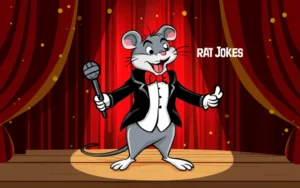Last Updated on April 10, 2025 by Henry James
Laughter as a Structural Misfire in Categorized Reality
The intersection of animals, food, and humans within the architecture of modern humor is not simply comedic filler — it is, in essence, a glitch in the symbolic ordering of the world. When a goose becomes a receptionist or a cupcake files a tax return, something far deeper than absurdity is occurring. We are watching meaning collapse gracefully under the weight of anthropomorphism, commodification, and the nervous giggle of late-stage cognition.
That a bear might walk into a bar is no longer strange; it is narratively expected. That the bar might refuse service is not a punchline — it’s a commentary on institutional failure. And when the bear pulls out his phone to check odds on PlayAmo Canada, the circuit completes: we’re no longer in a joke, we’re in a simulation. Humor here is neither relief nor rebellion; it is complicity with entropy.
The Animal as Comedian, Victim, and Mirror
The use of animals in jokes often hinges on one thing: inversion. They think, speak, and act like humans, but better — or worse — than we do. A dog that refuses to play fetch because it “has boundaries” is not only funny, it’s structurally offensive to human exceptionalism.
In this schema, the chicken who crosses the road no longer seeks a destination. It flees metaphor. It escapes the philosopher’s trap. It chooses, with or without motive, to act outside narrative coherence. That refusal becomes the joke — or rather, the joke becomes evidence that even a domesticated bird recognizes the absurdity of human frameworks.
We laugh, not because it’s absurd, but because it threatens to make sense.
Food That Thinks: Digesting the Joke Before It Eats You
When jokes anthropomorphize food, we are thrust into a surreal economy of guilt, desire, and edible consciousness. A broccoli begging for mercy or a pizza slice with abandonment issues doesn’t just create laughter — it activates a crisis of consumption.
The joke, here, is recursive. We consume the narrative of food resisting consumption, even as we digest it. The pun becomes the plate. This is culinary semiotics, not comedy. The fact that “lettuce romaine friends” circulates as humor is not a celebration of wit — it’s the domestication of despair via typography.
Food jokes are not about food. They are about the impossibility of eating ethically under capitalism, dressed up as fridge magnets and menu-board chalk scribbles.
The Human as Engine of Comic Collapse
If the animal resists categorization and the food destabilizes morality, the human becomes the collapsing axis of both. We are the punchline we try to dodge. Jokes about humans — especially in relation to animals or food — often point at the fragility of subjecthood.
Consider this: a man walks into a bakery, asks the sourdough for life advice, and leaves with less than he came in with. That’s not a joke. That’s autobiography with carbs. We don’t laugh because it’s clever. We laugh because it’s uncomfortably accurate. The joke doesn’t end — it loops.
Modern human-focused humor reveals that we are increasingly unsure of what it means to function, decide, or even exist without buffering. The joke is the last place where malfunction feels survivable.
The Ontological Undercurrent of Absurdist Juxtaposition
What becomes evident in the persistent triangulation of animals, edibles, and human agents within the comedic register is not merely a collapse of semiotic coherence, but the emergence of a liminal epistemology — one wherein the boundaries between subject and object, eater and eaten, speaker and spectacle, dissolve into performative flux. This recursive dynamic, wherein the joke operates as both vehicle and critique of its own ontological instability, gestures toward a broader condition: that of post-ironic cognition in an infosphere where symbolic categories are no longer grounded in material referents but in affective resonance engineered for circulation. Thus, to joke about a lasagna that sues its chef for misrepresentation is not only to invoke anthropomorphic satire, but to expose the fragility of narrative authority itself — and to reveal humor as the final aesthetic where collapse is not only acknowledged but ritualized.
Conclusion: Jokes That Don’t Want to Be Understood
Jokes about animals, food, and humans work not because they’re universal, but because they’re unstable. They point to systems breaking down and let us smile before we fall through. Laughter, in this sense, is a form of soft rebellion — a glitch you’re allowed to enjoy.
So the next time a fish explains inflation, or a hamburger writes a memoir, don’t just laugh. Ask yourself why the only thing that still makes sense… is nonsense.

Henry James is the humorist behind Haha Joks, a website where laughter reigns supreme. With a deep appreciation for wit and clever wordplay, Henry crafts and shares jokes that bring joy to readers of all ages. His mission is simple: to spread happiness, one joke at a time. Whether you’re looking for a quick giggle or a side-splitting laugh, Henry’s collection on Haha Joks is sure to deliver.









